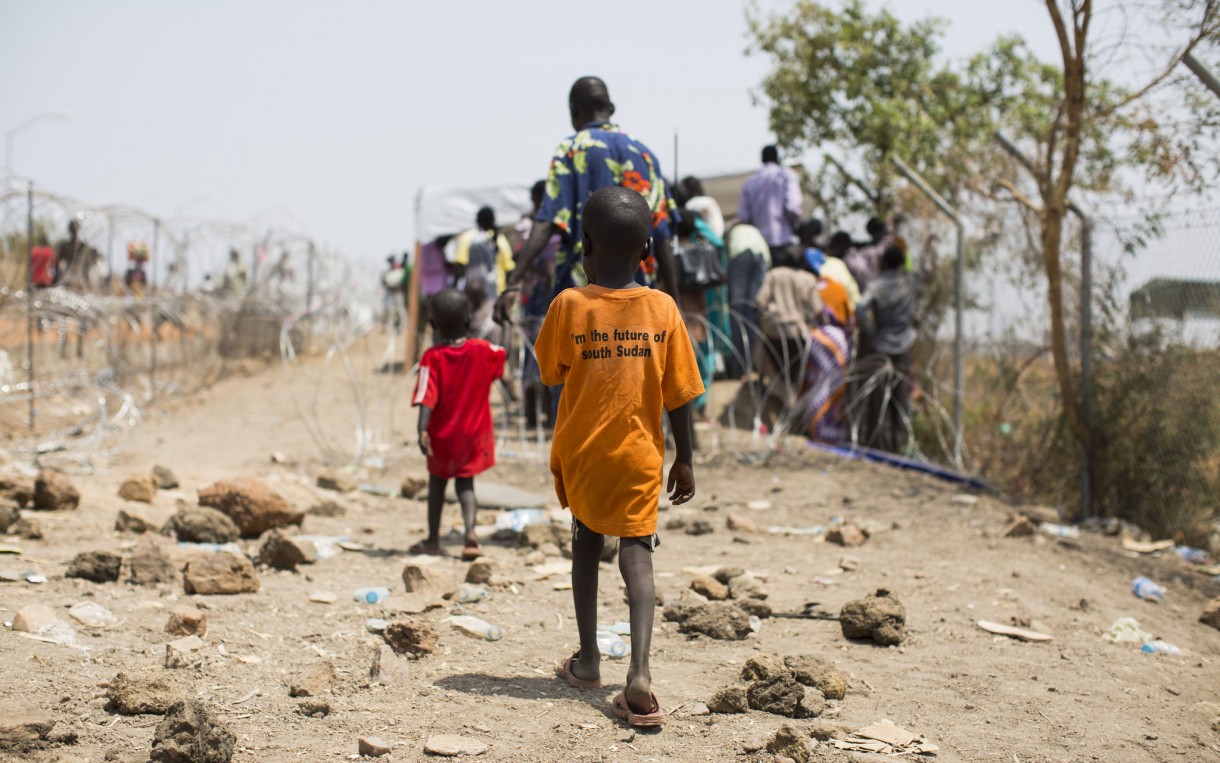One year later: Is the South Sudan crisis unique in humanitarian history?
 A young boy trails behind his father and brother as they walk through a "Protection of Civilians" site established at the United Nations in Juba. Photo: Mackenzie Knowles Coursin / Oxfam.
A young boy trails behind his father and brother as they walk through a "Protection of Civilians" site established at the United Nations in Juba. Photo: Mackenzie Knowles Coursin / Oxfam.
The world’s attention has a horrible tendency of wandering off Sudan and South Sudan’s problems before any are really solved for the future.
Jane Cocking is the Humanitarian Director of Oxfam Great Britain.
Civil war erupted in South Sudan last December as President Kiir accused his onetime deputy, Riek Machar, of plotting to overthrow him and fighters loyal to Machar seized control of several towns. Within a month, perhaps ten thousand people had been killed. Hundreds of thousands fled the carnage.
At this point almost every humanitarian agency was struggling to cope. The donor governments that had been slow to respond to signs warning of conflict in 2013 were now being equally slow to donate to the crisis. And by early May, the UN’s appeal was still short of 88% of the funds that it needed.
An international meeting on South Sudan, in Oslo in late May, did not exactly open the floodgates of funding. But slowly and surely, the humanitarian response has grown remarkably over the course of the year. In September, I was back travelling around several parts of South Sudan. Vast numbers of people were still living with the consequences of this grim conflict. But the worst predictions of famine had not come about. In part at least because of international humanitarian aid; and a lot, of course, due to the sheer resilience of South Sudan’s long-suffering people.
Generally speaking, independent agencies like Oxfam, donor governments and the UN were all coordinating well together. Oxfam itself was reaching almost 350,000 people. And now, more than $250 million has been donated since we castigated the slow response in May.
Sadly, that doesn’t mean that the plight of hundreds of thousands is anything but shocking. As well as extraordinarily committed aid workers, I met a 15-year-old girl forced into marriage to get help for herself and her siblings. I met families crammed into compounds, eating one meal a day. Perhaps worst of all, from almost everyone I spoke to, I heard a lack of hope in the future.
Three months on, I am still in awe of the enormous amount of work that humanitarian agencies are doing in South Sudan – but so sad that the predictions of increased violence I heard in September seem to be coming tragically true. One ceasefire agreement after another has not been respected. The hope that was once so strong with the coming of independence in 2011 has disintegrated into violence and antagonism. 1.3 million people are displaced within their country, 450,000 are refugees abroad, and four million people need humanitarian aid. A hundred thousand people who have fled to UN camps for safety are simply too frightened to leave them. It is a situation unique in humanitarian history.
At the end of this year of suffering, what does all this say for the future? If there is anything positive, it is that there has been a remarkable improvement in the humanitarian response since the country descended into violence twelve months ago, when most agencies were taken by surprise. That response has saved lives and, for now at least, prevented the worst predictions of famine from coming to pass.
What 2015 will bring is another question. So too is what the world can do when a humanitarian crisis is effectively created, not by climate change, drought or disaster – but by the conflict and ambition of political leaders. This is not a new challenge for us all. Thirty years ago, the terrible famine in Ethiopia was driven, in part at least, by that country’s long-running civil war, which international diplomacy noticeably failed to resolve.
Thirty years on, diplomacy has had precious little success in ending the suffering in South Sudan. What the world must do now is not just build on the good efforts already to make sure people can reach all the aid that they need, and rebuild their lives for the future. The governments of the region must display a far greater commitment to end the conflict too. And the outside world must stick by South Sudan in a way that it really never has done before.
It would be churlish to say that the international community forgets South Sudan. Some donor governments are very generous. World figures like John Kerry sometimes fly in. But the world’s attention has a horrible tendency of wandering off Sudan and South Sudan’s problems before any are really solved for the future.
In 2005, the peace deal between north and south Sudan was not followed by sustained international support, but by the world’s eyes turning away from the south to the turmoil taking place in Darfur. In 2011, South Sudan’s independence was followed by generous international aid to build the new state – but not by an equal commitment to tackle the new nation’s underlying problems, or to ensure the state became truly accountable to its people. And now the last year has shown how unrealistic it is to expect Kirr and Machar to work together for a sustainable peace without the constant attention of governments of both the region and wider international community.
The crisis that began in December 2013 is not over. Without continued improved assistance, it could still get worse in 2015. The international community cannot deliver peace easily. But it can stay with South Sudan for longer than it has in the past. And with that, it can help give South Sudan’s people a chance at least of the peace and development they hoped for only three years ago.